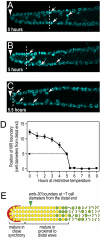Progression from a stem cell-like state to early differentiation in the C. elegans germ line
- PMID: 20080700
- PMCID: PMC2836686
- DOI: 10.1073/pnas.0912704107
Progression from a stem cell-like state to early differentiation in the C. elegans germ line
Abstract
Controls of stem cell maintenance and early differentiation are known in several systems. However, the progression from stem cell self-renewal to overt signs of early differentiation is a poorly understood but important problem in stem cell biology. The Caenorhabditis elegans germ line provides a genetically defined model for studying that progression. In this system, a single-celled mesenchymal niche, the distal tip cell (DTC), employs GLP-1/Notch signaling and an RNA regulatory network to balance self-renewal and early differentiation within the "mitotic region," which continuously self-renews while generating new gametes. Here, we investigate germ cells in the mitotic region for their capacity to differentiate and their state of maturation. Two distinct pools emerge. The "distal pool" is maintained by the DTC in an essentially uniform and immature or "stem cell-like" state; the "proximal pool," by contrast, contains cells that are maturing toward early differentiation and are likely transit-amplifying cells. A rough estimate of pool sizes is 30-70 germ cells in the distal immature pool and approximately 150 in the proximal transit-amplifying pool. We present a simple model for how the network underlying the switch between self-renewal and early differentiation may be acting in these two pools. According to our model, the self-renewal mode of the network maintains the distal pool in an immature state, whereas the transition between self-renewal and early differentiation modes of the network underlies the graded maturation of germ cells in the proximal pool. We discuss implications of this model for controls of stem cells more broadly.
Conflict of interest statement
The authors declare no conflict of interest.
Figures




References
-
- Li L, Xie T. Stem cell niche: Structure and function. Annu Rev Cell Dev Biol. 2005;21:605–631. - PubMed
-
- Knoblich JA. Mechanisms of asymmetric stem cell division. Cell. 2008;132:583–597. - PubMed
-
- Morrison SJ, Kimble J. Asymmetric and symmetric stem-cell divisions in development and cancer. Nature. 2006;441:1068–1074. - PubMed
-
- Kimble J, Crittenden SL. Controls of germline stem cells, entry into meiosis, and the sperm/oocyte decision in Caenorhabditis elegans. Annu Rev Cell Dev Biol. 2007;23:405–433. - PubMed
Publication types
MeSH terms
Substances
Grants and funding
LinkOut - more resources
Full Text Sources
Other Literature Sources

